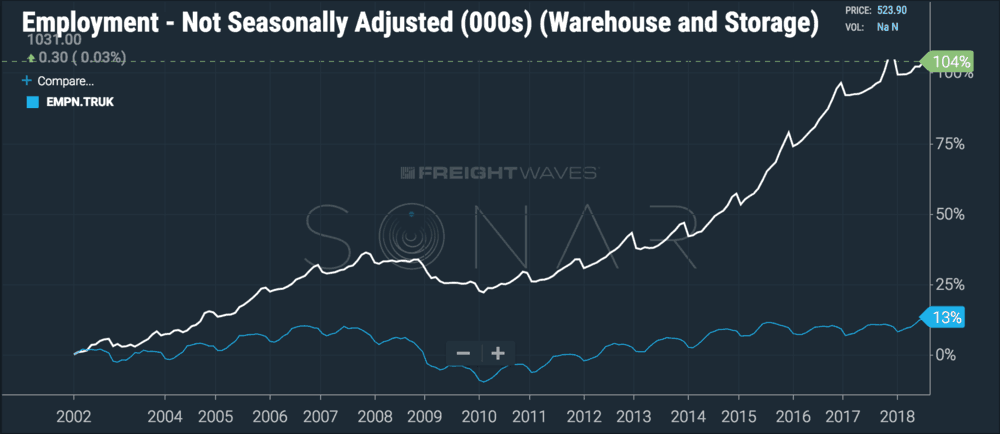The growth of e-commerce over the past decade has had a number of startling effects on the American economy: a dramatic intensification of parcel and last-mile delivery services; the ‘retail apocalypse’; a new abundance of data on consumer habits.
One of the most profound effects that e-commerce has wrought is largely invisible to the average consumer, but it affects hundreds of thousands of people: the transformation of warehousing and logistics. Total warehouse and distribution center square footage is rapidly rising, but the average facility size is decreasing and locations are shifting closer to urban cores to better serve population centers. Warehouse employment in the United States has essentially doubled since 2002. The chart below compares warehouse employment growth to trucking employment growth:

This trend is far from slowing down—in fact, warehouse employment growth continues to accelerate. CBRE Research released a report that said the United States’ warehouses and distribution centers would need an additional 450,000 workers next year.
Prologis (NYSE: PLD) wants to help. Prologis is the largest owner of warehouses and distribution centers in the world: goods worth 1.7% of global GDP flow through its 756M square feet of facilities each year; 816,000 people go to work in more than 3,700 Prologis facilities every day. The company is mostly known as a warehouse landlord, leasing space to about 5,500 customers in 19 different countries; now Prologis wants to extend its services to help its customers find workers.
Prologis recently announced the Community Workforce Initiative, in which it will collaborate with local workforce programs to help high schoolers in under-served communities get warehousing and logistics training. EXP, a Southern California nonprofit, is the CWI’s first partner and will help Prologis place 160 high schoolers in warehousing internships around the ports of Long Beach and Los Angeles.
FreightWaves spoke to Edward Nekritz, Chief Legal Officer and general counsel at Prologis, about the Community Workforce Initiative.
“We started thinking about this a year ago, making connections with our customers,” said Nekritz. “It became clear that a major pain point has been finding and retaining labor in their warehouses from the logistics, transport, and fulfillment perspective. We started thinking that we’re uniquely positioned, because of our scale and where we are, to help our customers with this pain point, and maintain and enhance our relationship with communities where we’ve developed real estate.”
Prologis sees a labor shortage in most of the roles involved in warehouse logistics, including office managers, equipment operators, pickers, packers, and conveyors. Because the labor needs are increasing across the board, Prologis and EXP had to provide training in everything from basic financial literacy to forklift driver certification. One of the key benefits of the program, Nekritz said, was that warehouse-intensive areas outside of major cities are often economically challenged—Prologis is trying to connect an underemployed population with an industry in the middle of a labor shortage.
“Where we rolled out in first in Southern California was in our port markets, which clearly have a significant need,” said Nekritz. “Some of the communities surrounding the warehouse areas don’t have a good, stable job environment. There was an established organization working specifically in logistics that needed a group like us to propel them to the next level. A lot of these interns and students are people who never would have thought about going into logistics in the past.”
Prologis wants to expand its internship program to other domestic markets—Nekritz said Prologis is looking specifically at Chicago—where the warehousing districts overlap with underserved communities. Eventually, Nekritz said, Prologis will expand the Community Workforce Initiative to Mexico and Europe before turning to Asia.
We were curious to hear about how Prologis thinks automation will affect the labor needs of the warehousing logistics sector. Although autonomous vehicle technology dominates media headlines, warehouses are being automated at a much faster rate than the transportation side of logistics.
“In terms of automation, some of our customers are further along than others,” said Nekritz. “Automation is coming, and we are acutely aware of that, and we are working with organizations that have the ability to flex in what their customers need. So the student who gets trained to operate a forklift today will be the same person who develops the mechanical skills to operate automated robots in the space in the future.”










